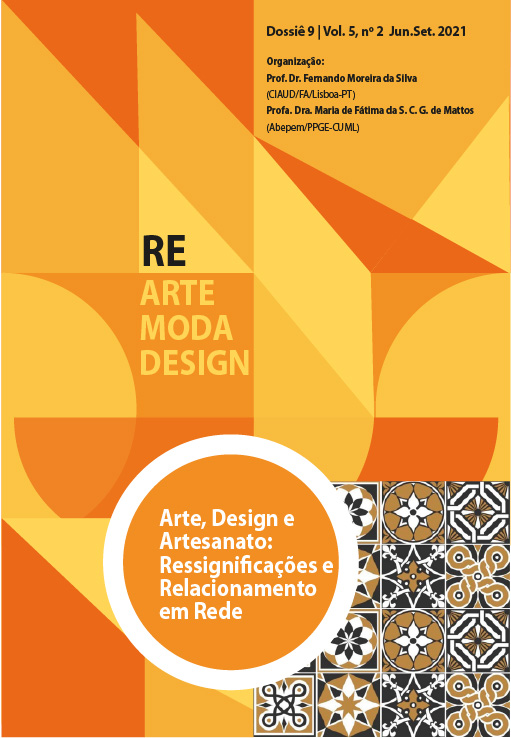Stampa digitale
rapporto tra tecnologia, design e superficie tessile
DOI:
https://doi.org/10.5965/25944630522021167Parole chiave:
stampa digitale, disegno, design di superficieAbstract
Il risultato della riproduzione dell'immagine nella stampa tessile è spesso influenzato dagli strumenti e dalle tecniche utilizzate nel suo processo di produzione. Attraverso ricerche bibliografiche e prove di stampa, sono state raccolte informazioni sulle tecnologie utilizzate nella stampa digitale, al fine di analizzare l'influenza di questo processo sulla stampa e riproduzione di immagini, su diversi substrati tessili e per comprendere i fattori rilevanti di questo processo. Sul mercato sono stati selezionati tessuti piatti di varie fantasie, secondo la composizione 100% cotone e 100% poliestere e la composizione mezza maglia 100% poliestere, questi sono stati stampati da un unico file con immagini differenti. Le immagini sono state stampate in tre risoluzioni: 300, 150 e 72 PPI. Le immagini con 150 PPI sono state escluse da questo articolo perché non presentavano differenze significative rispetto alle altre. I risultati sperimentali mostrano che ci sono differenze significative tra le caratteristiche studiate nelle immagini con una risoluzione di 300 PPI e 72 PPI e consente di organizzare uma serie di pratiche informative sulla tecnologia di stampa digitale su substrati tessili.
Downloads
Riferimenti bibliografici
A QUEDA dos 10 mitos da impressão digital. Blog Coralis. São Paulo, 23 ago. 2019. Disponível em: https://coralis.com.br/10mitos. Acesso em: 16 nov. 2019.
ASCHE, Tom P. Color management & quality output: working with color form camera to display to print. Reino Unido: Focal Press, 2014.
ASSOCIAÇÃO BRASILEIRA INDUSTRIA TÊXTIL E DE CONFECÇÃO (São Paulo) [Website]. Brasil: Consumo industrial de fibras e filamentos - 1970 a 2018. São Paulo, [2019?]. Disponível em: https://www.abit.org.br/uploads/arquivos/Consumo%20Industrial%20de%20Fibras%2
e%20Filamentos%20-%201970%20a%202018%20-.pdf. Acesso em: 25 ago. 2019.
BRIGGS-GOODE, Amanda; RUSSELL, Alex. Printed textile design. In: AMANDA BRIGGS-GOODE (ed.). Textile Design: principles, advances and applications. Cambridge: Woodhead, 2011. Cap. 5. p. 105-128.
CHATAIGNIER, Gilda. Fio a fio: tecidos, moda e linguagem. São Paulo: Estação das Letras,
165 p.
CIE, Christina. Ink jet textile printing. Cambridge: Woodhead, 2015.
FERREIRA, Herculano. Estamparia têxtil digital jato de tinta direto no tecido com corantes: Parte 2. O Serigráfico. Cotia, p. 12-13. set. 2015. ISSN 2175-0335 versão online. Disponível em: https://issuu.com/jornaloserigrafico/docs/oserigrafico-edicao-233-setembro. Acesso em: 16 nov. 2018.
LASCHUK, Tatiana; RÜTHSCHILLING, Evelise Anicet. Adequação dos processos de estamparia nas etapas produtivas de produtos de moda e vestuário. In: Colóquio de Moda. 11., 2015, Curitiba. Anais […]. Curitiba, 2015. Disponível em: http://www.coloquiomoda.com.br/anais/Coloquio%20de%20Moda%20-%202015/ARTIGOS-DE-GT/GT04-DESIGN-E-PROCESSOS-DE-PRODUCAO-EMMODA/GT-4-ADEQUACAO-DOS-PROCESSOS-DE-ESTAMPARIA.pdf. Acesso em: 27 out. 2019.
LUPTON, Ellen; PHILLIPS, Jennifer Cole. Novos fundamentos do design. São Paulo: Cosac Naify, 2008.
NEIRA, Luz García. Estampas na tecelagem brasileira: da origem à originalidade. 2012. 306 f. Tese (Doutorado em Arquitetura e Urbanismo), Faculdade de Arquitetura e Urbanismo, Universidade de São Paulo, São Paulo, 2012. Disponível em: https://www.teses.usp.br/teses/disponiveis/16/16133/tde-28112012-101324/publico/tese_luz_original.pdf. Acesso em: 10 fev. 2018.
SHUTTERSTOCK. Flor de Lótus. [Nova York], 2016. 1 fotografia. Disponível em: https://shutterstock.com. Acesso em: 5 mai. 2016.
SHUTTERSTOCK. Flor com detalhes azuis, digitalização de livro. [Nova York], 2016. 1 fotografia. Disponível em: https://shutterstock.com. Acesso em: 5 mai. 2016.
SHUTTERSTOCK. Textura de cobra. [Nova York], 2016. 1 fotografia. Disponível em: https://shutterstock.com. Acesso em: 5 mai. 2016.
SINCLAIR, Rose. Textiles and Fashion: materials, design and technology. Cambridge: Woodhead, 2015. 894 p.
WILSON, Jacquie (ed.). Handbook of textile design: principles, processes and practice. Cambridge: Woodhead, 2001. 152 p.
Pubblicato
Come citare
Fascicolo
Sezione
Licenza
Copyright (c) 2021 Regina Aparecida Sanches, Cláudia Regina Garcia Vicentini, Suzana Avelar, Rejane de Oliveira Souza

TQuesto lavoro è fornito con la licenza Creative Commons Attribuzione 4.0 Internazionale.
- Gli autori conservano i diritti d'autore e concedono alla rivista il diritto della prima pubblicazione, con l'opera simultaneamente licenziata sotto la Licenza Creative Commons Attribuzione 4.0 Internazionale, la quale permette:
1. Condividere — copiare e ridistribuire il materiale su qualsiasi supporto o in qualsiasi formato, per qualsiasi fine, anche commerciale.
2. Adattare — remixare, trasformare e creare a partire dal materiale per qualsiasi fine, anche commerciale. Il licenziante non può revocare questi diritti finché vengono rispettati i termini della licenza.
In accordo con le seguenti condizioni:
1. Attribuzione — È necessario attribuire la paternità dell'opera in maniera appropriata, fornire un link alla licenza e indicare se sono state effettuate delle modifiche. Questo deve essere fatto in qualsiasi circostanza ragionevole, ma non in modo tale che suggerisca che il licenziante avalli l'utilizzatore o il suo utilizzo.2. Nessuna restrizione aggiuntiva — Non è possibile applicare termini legali o misure tecnologiche che limitino legalmente altri dallo fare qualsiasi cosa la licenza permetta.
-
Il plagio, in tutte le sue forme, costituisce un comportamento editoriale eticamente scorretto ed è inaccettabile. Questa rivista utilizza il software di controllo della similarità iThenticate.






